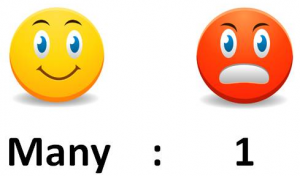 In relationships, accentuate the positive. Negative interactions have more clout than positive interactions. It is not a balanced equation. You need to have many positive interactions for each negative interaction, if you want a healthy, sustainable relationship!
In relationships, accentuate the positive. Negative interactions have more clout than positive interactions. It is not a balanced equation. You need to have many positive interactions for each negative interaction, if you want a healthy, sustainable relationship!
Relationship expert John Gottman sees each of our daily interactions with another person as bids for connection. By choosing to turn toward, to turn away, or turn against each other’s bid for connection, no matter how ordinary or small, we establish a foundation that could determine the future success or failure of our relationship. Good relationships, and trust building, usually develop slowly over time, growing out of the many mundane, little interactions we share each day.
I’ve been a fan of Gottman for years. If nothing else, my biggest takeaway from his work is that the little things add up, one way or the other!It’s as psychotherapist Kate Feldman says, daily life is foreplay for relationships.
Magic ratios
What is the optimal ratio of positive bids versus negative interactions, the magic relationship ratio?
Gottman has discovered that with couples, its 5:1, 5 positive for each negative interaction. He has observed couples for over 30 years, at his apartment-style laboratory, the love lab, at the University of Washington. He found he could predict whether a marriage would last, or end in divorce, with 90% accuracy. (Note: Gottman observed 0.8:1 as indicator of marriage likely to fail).
And if we think of magical ratios beyond the sphere of intimate relationships…
Popular social media strategist Chris Brogan suggests (in this post) promoting others 12 times for every time you promote yourself. In a similar vein, Victoria-based social media expert Chris Burdge suggests a similar (10:1) ratio, of value-add versus (personal) marketing, as a barometer of good Twitter practice.
As a parent, I recall 3:1 as the magic ratio for praising vs. disciplining young children. Does this still apply?
In cultures and generations where reprimand and discipline rule(d), maybe a negative ratio applies / is the norm?
What’s yours?
And in your world… What’s your magic relationship ratio for thinking about the health of a relationship or collaboration?
If you enjoyed this post, please consider leaving a comment or subscribing to my blog. Thanks, Ben.

This is good reminder, Ben, of the need to ‘pay it forward.’ Hopefully we don’t have to calculate our positive relationship investments but we do have an intuitive sense that we need many more positives than negatives.
Thanks for your feedback Lorne. Yes… the ratio idea is very much ‘pay it forward’. On the calculation front, I would add that sometimes it can be helpful to occasionally assess one’s positive/negative ratio, especially as one is learning a new habit – e.g., being more positive. Once the habit is internalized, then for sure its as you say … go with your intuition.
In our research we’ve noted that a negative far outweighs a positive, but this is the first time I’ve seen it quantified. Very interesting.
FWIW, our “laboratory” is an intentional community.
Cinn… It’s difficult to quantify, with confidence, the effects of positive vs. negative interactions. It helps if you have, like Gottman, 20+ years of detailed observations/data to work with!